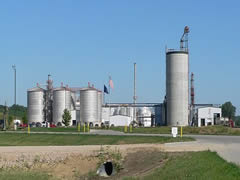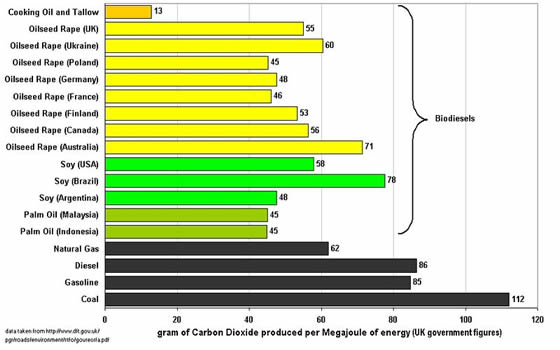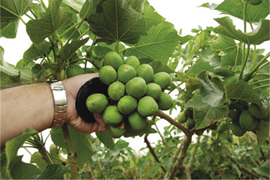Hope in Jatropha:
Give Biofuels a Chance to Grow
By Brook & Gaurav Bhagat

As the energy demand increases, the global supply of fossil fuels decreases, causing inflation, instability and war; the emissions from fossil fuels cause immediate harm to human health and contribute to the greenhouse effect; and, deforestation and the destruction of agricultural lands threaten to turn this Earth into a desert, bit by bit. Like this, how long can we go on? There is no doubt that the end of the fossil fuel age is not far off.
Then what? How can we combat desertification, reduce the need for oil, and help heal the present wounds in the environment, all in one stroke?
A visionary scientist among politicians, A. P. J. Abdul Kalam, the president of India, sees an answer in biofuel. In his Presidential address at the conclave, he recognized biofuel, and specifically the plant jatropha, as worthy of mention. Discussing the national problems of water scarcity and drought, he stated that India “needs to grow jatropha to tackle dry land and generate bio-diesel."
India
India is particularly well-suited for the honor of heralding in a green alternative fuel because of its:

- estimated 50 to 130 million hectares of wastelands-- saline lands (from mining), degraded forests, and other land unavailable for agricultural use due to overfarming;
- resulting shifting sand dunes and continuing process of desertification;
- fastest growing population rate in the world-- increasing the need for food, energy, and employment;
- rural/agricultural population of over 70%: biofuel screw presses are simple to make, and can be produced and maintained by a village blacksmith
- huge national crude oil bill-- second only to defense spending;
- constant battle with drought and shortages of water and electricity;
- warm climate, agreeable both to growing biofuels and running engines that use them.
R. P. S. Katwal, Director General of the Indian Council of Forestry Research and Education, said that the Union government had drawn up a blueprint to plant Jatropha trees on 50,000 hectares at a cost of Rs 1,430 crore (14.3 billion). “Biofuels are gaining importance in the light of increasing energy demand, especially fossil fuels which are non-renewable. Biofuels are renewable, biodegradable, non-hazardous and safer for air, water and soil and its use reduces the emission of greenhouse gases."
Other projects are funded from abroad, like the proposed $2.5 million pilot project in Hyderabad, Rajasthan, which will produce 10 tons of biodiesel per day. Raw oils from pongamia, jatropha, and other trees will be sourced from local farmers who are expected to be the major beneficiaries. The German Development Corporation (GTZ) is currently working with the promoters, Southern Biofe Biofuels Pvt. Ltd., to prepare a detailed project proposal for possible funding by German companies and the German government.
Daimler Chrysler and Hohenheim University (also German) are conducting a research project in two different climatic zones of India. Each plantation will consist of 20 hectares of jatropha trees planted on wastelands-- one caused by industrialization and the other by natural soil erosion. Other aspects include test vehicles and research laboratories. After the five-year research period, it is hoped that the plantations will become self-sustaining, profitable enterprises.
The current rate of Indian development of biofuels, particularly biodiesel, is just a drop in the bucket when compared to its potential. If 10 million hectares of its vast and sometimes destructive wastelands were used for biodiesel production, with a modest estimate of 1.5 tons of seeds per hectare, 4 million tons of biodiesel would be produced-- one tenth of the country’s annual oil requirement. If one person was employed per hectare, that would mean 10 million new jobs. And, for use or sale, 11 million tons of organic seedcake fertilizer or livestock feed and 0.4 million tons of technical grade glycerol would be produced.

Ethanol
Ethanol is the most widely used biofuel in the world; technological advances have lowered the cost of its production and processing. Brazil boasts one of the largest green fuel programs in existence: petrol-only engines have been banned and replaced by engines that use pure ethanol or a 78-22 petrol-ethanol blend. The shift has greatly benefited the country environmentally and economically, creating employment and reducing the need for foreign oil. Its hot, wet climate is well-suited to the production of sugarcane (from which ethanol is made), and farmers especially have profited.
India is also one of the biggest worldwide producers of sugarcane, but its constant struggle with water shortages in many areas makes growing this crop problematic. However, due to overproduction, sugar prices crashed, and there are actually stockpiles of sugar and spoilt food grain which have no use. These can be used to make ethanol.
Since January 2003, a minimum 5% ethanol blend in petrol has been mandatory in India in nine states and four Union territories. By 2005, the ethanol content should reach 10%. Undoubtedly, ethanol is an important biofuel for petrol engines, but its potential is limited in India due to the high amounts of water required for its production.
Jatropha
Jatropha curcas, also known as physic nut, is unique among biofuels. Although oil can be extracted from over 80 known plant species,
jatropha is currently the first choice for biodiesel. Per hectare, yields vary from 0.5 to 12 tons/year depending on soil and rainfall conditions (Makkar and Becker, 1999). An average of about 5 tons of seeds per hectare can be produced under optimum conditions. The oil content of the seed is 55-60%, which can be converted into biodiesel by transesterification. An annual yield of 0.75 to 2 tons of biodiesel could be expected per hectare from the fifth year onwards (Fiodl and Eder, 1997).
What makes jatropha especially attractive to India is that it is a drought-resistant and can grow in saline, marginal and even otherwise infertile soil, requiring little water and maintenance. It is hearty and easy to propagate-- a cutting taken from a plant and simply pushed into the ground will take root. It grows 5 to 10 feet high, and is capable of stabilizing sand dunes, acting as a windbreak and combating desertification. It has been most successful in the drier regions of the tropics with annual rainfall of 300-1000 mm. It grows naturally at lower altitudes (0-500 m) in areas with average annual temperatures well above 20°C, but can grow at higher altitudes and tolerate slight frost.
Jatropha naturally repels both animals and insects-- it can be planted along the circumference of farms to protect other crops. Jatropha seedcakes, produced as a by-product of pressing the oil, make an excellent organic fertilizer or protein-rich livestock feed, and another by-product is glycerine. The plant lives, producing seeds, for over 50 years.
Other parts of the plant are also useful: dark blue dye and wax can be produced from the bark, the stem can be used as a poor quality wood, and the roots help in making yellow dye. The flowers of Jatropha curcas and the Jatropha stem have well-known medicinal properties, and the leaves can be used for dressing wounds. All these things can be used, or sold.
Alternate uses of the oil include varnishes, illuminants, soap, organic insecticide, and medicine for skin diseases, cancer, piles, snakebite, paralysis, dropsy and more.
Biodiesel

The Indian Supreme Court has recently banned the use of undiluted petrodiesel for commercial vehicles in Delhi due to its adverse effects on health, and other cities are reported to have followed suit.
As compared to petrodiesel, biodiesel almost completely eliminates lifecycle carbon dioxide emissions. It reduces emission of particulate matter by 40-65%, unburned hydrocarbons by 68%, carbon monoxide by 44-50%, sulphates by 100%, polycyclic aromatic hydrocarbons (PAHs) by 80%, and the carcinogenic nitrated PAHs by 90% on an average. The biodiesel molecules are simple hydrocarbon chains free of the aromatic substances and sulfur associated with fossil fuels.
Although biodiesel does produce more NOx emissions than petrodiesel, these emissions can be reduced through the use of catalytic converters. In petrodiesel vehicles, catalytic converters have generally not been included because the sulfur in the fuel destroys them, but biodiesel does not contain sulfur.
According to most sources, biodiesel can be used in any diesel engine or burner without adaptation. It has a higher cetane number of biodiesel compared to petrodiesel, indicating potential for higher engine performance and causing less knocking. Tests have shown that biodiesel has similar or better fuel consumption, horsepower, and torque and haulage rates than conventional diesel; the use of biodiesel complements the working of the catalysator and can help a current EURO-1 motor attain the EURO-111 standards.
It is true that, because of the solvent power of biodiesel, especially older engines or machines can get clogged, but this is because the biodiesel is actually cleaning it, dissolving the residues left by petrodiesel. Rubber gaskets and hoses in vehicles made prior to 1992 may also be degraded, and need to be replaced. Engine efficiency is also increased by its superior lubricating properties, and the more complete combustion of hydrocarbons due to its higher oxygen content (up to 10%). Finally, biofuel is safer to store because of its higher flash point.
Why Not?
One noteworthy drawback of especially undiluted biodiesel (BD100) is its cold-clogging point of 0 degrees Celsius. This is one of the reasons it is usually mixed with conventional diesel, especially in cold countries. This is not a problem, however, in most of India, except in winter in the higher altitudes of the Himalayas.
The argument that biofuels are not energy efficient, due to the oil used to irrigate, fertilize and plow the land is irrelevant in the case of jatropha-- both irrigation and fertilization are generally unnecessary,
 or its own seedcakes can be used as fertilizer. The energy efficiency of the current agricultural and industrial production process is reported (in Nicaragua) to be between 1:3.75 and 1:5.
or its own seedcakes can be used as fertilizer. The energy efficiency of the current agricultural and industrial production process is reported (in Nicaragua) to be between 1:3.75 and 1:5.
Another common objection to biomass energy production is that it could divert agricultural production away from food crops in a hungry world. Using wastelands, however, instead of farmlands, solves the "food or fuel" dilemma-- these lands are unsuitable for growing other crops. Also, if a biofuel like jatropha is grown, drought and water shortages which would ruin food crops can be survived; if grown in addition to food crops, as mentioned above, it can literally protect them from animals, insects and desertification, and its seedcakes can be used as fertilizer.
The most difficult problem is, as always, cost. In remote areas, where fossil fuels are not readily available, biodiesel is already a feasible alternative, especially considering wasteland reclamation, rural employment and income generation from jatropha biodiesel and its by-products. This is important to consider in India, where electricity is always in short supply-- biodiesel can power generators, lights and farm equipment as well as cars. On the current global market, however, biodiesel generally cannot directly compete with petrodiesel, at least not yet.
The main reason for this is that biodiesel is not being produced on a large scale. The industry is a fragmented network of small companies whose costs and prices are high. Two British biodiesel companies, however, found a solution by listing their company names on the stock market in order to fund large, efficient production facilities, and passing the savings on to consumers. In other parts of the world as well, as production increases, the cost differential of biofuels is decreasing steadily.
What Now?
Ironically, the first diesel engine ever made, in 1893, was powered by peanut oil-- a biofuel. By the 1920’s the petroleum industry had all but eliminated the biofuel infrastructure
 and usurped the market with petrodiesel because it was cheaper to produce. Even then, the engine’s inventor, Rudolf Diesel, maintained that “the use of vegetable oils for engine fuels may seem insignificant today, but such oils may become, in the course of time, as important as petroleum and the coal-tar products of the present time."
and usurped the market with petrodiesel because it was cheaper to produce. Even then, the engine’s inventor, Rudolf Diesel, maintained that “the use of vegetable oils for engine fuels may seem insignificant today, but such oils may become, in the course of time, as important as petroleum and the coal-tar products of the present time."
Now, almost a century later, the world has no choice but to listen or perish in pollution and war. As time goes by and global reserves of fossil fuels shrink, the biofuel industries have to grow up fast, and India is in a good position to step up to the opportunity. The government should give tax concessions or other financial incentives to biofuels companies and consumers to speed up the progress, and urge other nations to do the same. With biofuels, we can help heal and preserve the air, the land, our own physical health and peace.
Did you like the article? Subscribe here to our New Article Email Alert or RSS feeds.
Sharing is caring! Don't forget to share the love, and keep the conversation going by leaving a comment below:
Advertisement

